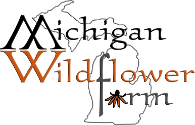Article written for the Wildflower Association of Michigan Newsletter (Fall 2002)
A lot of you have made the decision to end the slave relationship with your lawn mower. The desire to decrease the need for mowing motivates many to consider planting a prairie where once there was water-hungry, drug-dependent lawn. But wait – don’t put that mower out on the curb just yet! It just may be the most effective tool in managing your prairie. The importance of management in the first year of prairie establishment cannot be overemphasized-think about the time invested in the site preparation and the money invested in seed.
Unfortunately, non-native weed seeds will find an opportunity to establish themselves on the site that you have so carefully prepared for native plant species. It’s up to you, the manager of the site, to keep the undesirables at bay. One of the simplest ways to do this is to commit to a mowing regime for the first season post-seeding. In Michigan, this mowing regime would take place April through October. This means that each time vegetation growth reaches 10-12 inches, it should be mowed to 4-6 inches. For larger areas, cutting can be with a brush hog or flail mower; for medium-sized areas, a lawn mower set high; for small or steep sloped areas, a weed whip will do the work nicely. Depending upon the growing conditions of the season, 3-5 mowings can be anticipated. It is critical that this form of management be followed throughout the entire season, so that spring, summer, late summer and fall weeds can be controlled. Mowing a prairie as instructed can benefit the establishment of native forbs and grasses in several ways: With timely cuttings, weeds such as barnyard grass, foxtail, pigweed, lambsquarters, ragweed, and mare’s-tail are prevented from reseeding. Annual weeds can infest a planting with amazing speed. If these annual weeds are cut prior to seeding, they should not exist in the planting next season. (Note: Although cutting perennial weeds will prevent them from reseeding in most cases, the mother plant will still exist.) Some especially problematic perennial weeds are spotted knapweed, Canada thistle, purple loosetrife, field bindweed, plantain, and quack grass. Other methods must be used to control these plants.
It is much easier to deal with problems early in the game, and this applies to plants, too. Fire, herbicide and physical removal can be used for controlling perennial weeds. In many cases, once perennial native wildflowers have been mowed, their energy will focus on root development, making for a stronger plant next season. You may sacrifice some blooms of black-eyed Susan and bergamot the first season, but the weed control is worth it. Cutting taller competing growth allows sunlight and moisture to reach the soil and germinate desirable seedlings. Implementing a mowing regime in the first year also helps curb our desire to achieve instant results (something we seem to expect, even while knowing, intellectually, that establishing a planting requires three to five years). Disappointment is less likely in year one if we know that the site will be mowed all year. Committing to a mowing regime in the first year of establishment is a simple and effective way to manage your planting-I encourage you to give it a try!

